

How to Insert a Memory Into the Brain of a Sleeping Mouse. The lab mice awoke with happy memories… that researchers had inserted into their brains while they slept.
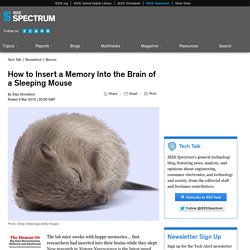
New research in Nature Neurscience is the latest proof that we may soon live in a Philip K. Dick short story, where synthetic memories can be created via neural stimulation. Hyperbole aside, here’s how they did it. The researchers set out to test the following hypothesis: Animals consolidate memories while sleeping by reactivating neurons associated with the remembered experience. In five mice, the researchers used a clearly defined spatial memory. Snorting a Brain Chemical Could Replace Sleep. In what sounds like a dream for millions of tired coffee drinkers, Darpa-funded scientists might have found a drug that will eliminate sleepiness.
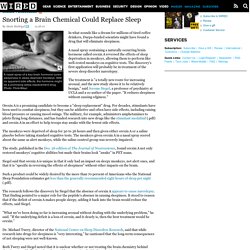
A nasal spray containing a naturally occurring brain hormone called orexin A reversed the effects of sleep deprivation in monkeys, allowing them to perform like well-rested monkeys on cognitive tests. The discovery's first application will probably be in treatment of the severe sleep disorder narcolepsy. The treatment is "a totally new route for increasing arousal, and the new study shows it to be relatively benign," said Jerome Siegel, a professor of psychiatry at UCLA and a co-author of the paper. "It reduces sleepiness without causing edginess. " 4 Wearables That Give You Superpowers. Learn more. NAO uses four directional microphones to detect sounds, and his voice recognition and text-to-speech capabilities allow him to communicate in 19 languages.
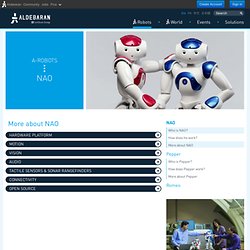
Sound Source Localization One of the main purposes of humanoid robots is to interact with people. Sound localization allows a robot to identify the direction of sounds. To produce robust and useful outputs while meeting CPU and memory requirements, NAO sound source localization is based on an approach known as “Time Difference of Arrival.” When a nearby source emits a sound, each of NAO’s four microphones receives the sound wave at slightly different times. For example, if someone talks to NAO on its left side, the corresponding sound wave first hits the left microphones, then the front and rear microphones a few milliseconds later, and finally the right microphone. BCG Puts Pricetag on the Rise of the Robots - Real Time Economics. Timeline of the Far Future. A Few Questions For Peter W. Singer About The Future Of Cybersecurity. Peter W.
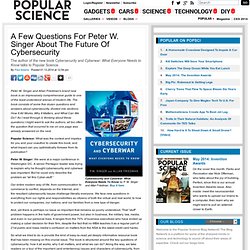
Singer and Allan Friedman's brand new book is an impressively comprehensive guide to one of the least understood arenas of modern life. The book consists of some five dozen questions and answers about cybersecurity, divided into sections: How It All Works, Why It Matters, and What Can We Do? China cloning on an 'industrial scale' 13 January 2014Last updated at 19:35 ET.

THE FUTURE OF US: TRANSCENSION HYPOTHESIS. Brain Controlled Exoskeletons, Stem Cell Regeneration, Transgenic Monkeys, Progress on Cyborg fixes for paralysis expected in 2014. TweetThe journal Nature listed out expected developments in science during 2014 Transgenic monkeys Several research groups, including a team led by geneticist Erika Sasaki and stem-cell biologist Hideyuki Okano at Keio University in Tokyo, hope to create transgenic primates with immune-system deficiencies or brain disorders.

MagLIF fusion wants to use 30 tesla magnets, 27 megaAmpere Z Pinch and 8 kilojoules laser may get close to fusion ignition in 2015. Researchers working on Sandia’s Magnetized Liner Inertial Fusion (MagLIF) experiment added a secondary magnetic field to thermally insulate the hydrogen fuel, and a laser to preheat it (see ‘Feeling the pinch’).

In late November, they tested the system for the first time, using 16 million amperes of current, a 10-tesla magnetic field and 2 kilojoules of energy from a green laser. “We were excited by the results,” says Mark Herrmann, director of the Z machine and the pulsed-power science centre at Sandia. Artificial worm starts to wriggle. 20 December 2013Last updated at 09:49 ET The project to create the C. elegans nematode in code should unlock more secrets of how it lives A project to create artificial life has hit a key milestone - the simulated creature can now wriggle.
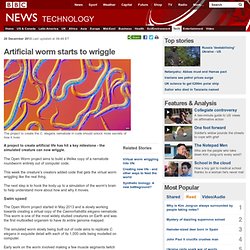
The Open Worm project aims to build a lifelike copy of a nematode roundworm entirely out of computer code. This week the creature's creators added code that gets the virtual worm wriggling like the real thing. The next step is to hook the body up to a simulation of the worm's brain to help understand more about how and why it moves. Swim speed The Open Worm project started in May 2013 and is slowly working towards creating a virtual copy of the Caenorhabditis elegans nematode. Self-assembling computer chips : Futurology. A Scientist Predicts the Future - NYTimes.com.
Grindhouse Wetwares Has Got Science Fiction's Future Under Its Skin. In the 1970s, "The Six Million Dollar Man" said of Steve Austin's broken human body, "We can rebuild him, we have the technology.

" Except that it was a fiction, and we still don't have the technology. Some transhumanists are tired of waiting. Scientists Control One Person's Body With Another Person's Brain. This Spray-On Chemical Could Make Window Blinds Obsolete. Social robots see smell. "The thing that's been missing in robotics is a sense of smell," said biology professor Joseph Ayers.
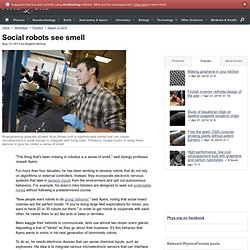
For more than four decades, he has been working to develop robots that do not rely on algorithms or external controllers. Instead, they incorporate electronic nervous systems that take in sensory inputs from the environment and spit out autonomous behaviors. For example, his team's robo-lobsters are designed to seek out underwater mines without following a predetermined course. "Now people want robots to do group behavior," said Ayers, noting that social insect colonies are the perfect model. "If you're doing large field explorations for mines, you want to have 20 or 30 robots out there.
" Beware Brutalism: Concrete-eating robot "literally erases buildings" Bain's list of eight trends to 2020. Bain forecasted eight Trillion-Dollar Growth Trends to 2020. (44 page pdf) Macro trend: The next billion consumers. The rising wealth of emerging economies will continue to bring a broader range of consumption goods to huge numbers of new consumers. IBM's Watson Reloaded: Deity 2.0. IBM’s Watson is like nothing we have ever seen before. While humans use neuronal networks to store information in the brain, Watson has the ability to use the Internet and internal data as its extended mind. When asked a question, it creates a statistical average based upon the information gathered, and gives a confident probabilistic answer.
With Latest Tech, Can Doctors Treat Us Before We Fall Sick? Chinese Firm Gains Approval, Hype to Raise World’s Tallest Building in Only 90 Days. China has ten cities bigger than New York. Almost half of the world’s 20 tallest skyscrapers under construction today are in China. 3D Printed Food and The Future of Chefs. Apple's Anki: Merging Physical and Digital Worlds. Monster Dreamer: Imaginary to Real in Five Minutes. Waterless Washing Machine. The Solar Future of Luxury Yachting. This wireless brain implant could make telekinesis a reality.
Brown University researchers have developed a fully implantable and rechargeable wireless brain sensor capable of transmitting neural data to an external receiver.
Tech. Space. FPBR-Predictions-2012.pdf. Medicine. Society. Enviroment. H+